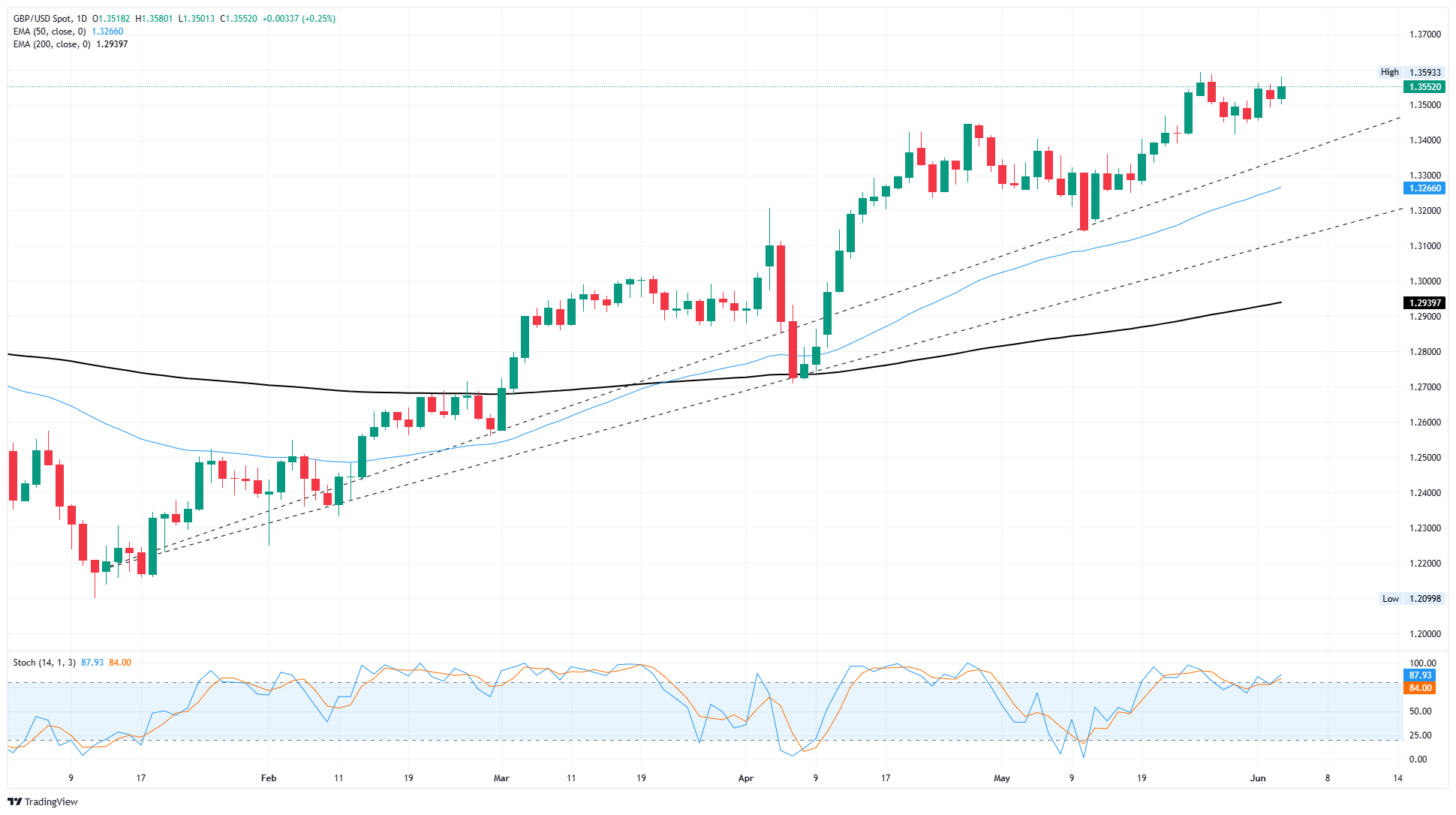GBP/USD sticks close to near-term highs as key labor data looms
- GBP/USD remains close to recent peaks as the Greenback remains off-kilter.
- US ADP jobs softened much faster than expected on Wednesday, knocking back investor sentiment.
- Friday’s upcoming NFP labor print has taken on newfound importance as markets fret over tariff impacts.
GBP/USD caught a bid on Wednesday, paring the previous day’s losses and keeping price action on the high side of recent congestion. Bids remain pinned firmly above 1.3500 with key US Nonfarm Payrolls data looming ahead later in the week. US Dollar flows continue to dominate markets this week, with a thin offering from the UK side of the economic data docket until next week’s UK labor figures.
ADP Employment Change numbers dropped sharply in May, adding just 37K jobs, far below the expected 115K increase. Historically, ADP job figures are volatile and often poorly predict Nonfarm Payrolls (NFP) that soon follow. This Friday’s NFP release will hold added significance as investors grow concerned about the American economy’s labor sector. Increasingly wary of business conditions due to fluctuating White House trade policies, many companies are scaling back hiring and investment plans.
The ISM Services Purchasing Managers' Index (PMI) survey results further dampened investor sentiment on Wednesday, indicating that service sector operators are growing more pessimistic about growth. The aggregated results fell to a contractionary 49.9, an 11-month low.
Trade deals remain elusive, key jobs data still looms ahead
Wednesday was the deadline set by the Trump administration for trading partners to present their best trade deal offers. Countries were expected to submit offers to negotiate out of President Trump’s proposed “reciprocal” tariffs package announced in April but suspended for 90 days last minute. The administration remained relatively quiet on trade deals, implying that responses may not be as numerous as earlier suggested by Trump officials.
Thursday follows up Wednesday’s cautious prints with a relatively thin showing on the economic calendar, though a smattering of Federal Reserve (Fed) officials are expected throughout the upcoming US market session. Most of the market will be on the lookout for further trade headlines, as well as looking ahead to Friday’s NFP data dump, including net job gains and Average Hourly Earnings during May.
GBP/USD price forecast
GBP/USD found further technical support from the 1.3500 handle, helping to keep bids bolstered through Wednesday’s market session. Cable bulls are beginning to show signs of strain from keeping price action elevated, but the short side is looking equally weak as the pair runs well ahead of key long-term moving averages.
GBP/USD daily chart

Pound Sterling FAQs
The Pound Sterling (GBP) is the oldest currency in the world (886 AD) and the official currency of the United Kingdom. It is the fourth most traded unit for foreign exchange (FX) in the world, accounting for 12% of all transactions, averaging $630 billion a day, according to 2022 data. Its key trading pairs are GBP/USD, also known as ‘Cable’, which accounts for 11% of FX, GBP/JPY, or the ‘Dragon’ as it is known by traders (3%), and EUR/GBP (2%). The Pound Sterling is issued by the Bank of England (BoE).
The single most important factor influencing the value of the Pound Sterling is monetary policy decided by the Bank of England. The BoE bases its decisions on whether it has achieved its primary goal of “price stability” – a steady inflation rate of around 2%. Its primary tool for achieving this is the adjustment of interest rates. When inflation is too high, the BoE will try to rein it in by raising interest rates, making it more expensive for people and businesses to access credit. This is generally positive for GBP, as higher interest rates make the UK a more attractive place for global investors to park their money. When inflation falls too low it is a sign economic growth is slowing. In this scenario, the BoE will consider lowering interest rates to cheapen credit so businesses will borrow more to invest in growth-generating projects.
Data releases gauge the health of the economy and can impact the value of the Pound Sterling. Indicators such as GDP, Manufacturing and Services PMIs, and employment can all influence the direction of the GBP. A strong economy is good for Sterling. Not only does it attract more foreign investment but it may encourage the BoE to put up interest rates, which will directly strengthen GBP. Otherwise, if economic data is weak, the Pound Sterling is likely to fall.
Another significant data release for the Pound Sterling is the Trade Balance. This indicator measures the difference between what a country earns from its exports and what it spends on imports over a given period. If a country produces highly sought-after exports, its currency will benefit purely from the extra demand created from foreign buyers seeking to purchase these goods. Therefore, a positive net Trade Balance strengthens a currency and vice versa for a negative balance.